Dr Becker was afforded the unique opportunity to participate in Large Animal
Rescue Training as taught by Drs Tomas and Rebecca Gimenez of Clemson University. On
the weekend of 9-10 February 2002, along with a fellow TRACER team member Rich
Baltzell, she attended the Rescue Workshop in Walterboro, South Carolina. That class
was made possible through the generous sponsorship by the Campbell Veterinary
Clinic. Also assisting was the Charleston County Rescue Squad. The purpose of
the workshop was to demonstrate safe and effective means of rescuing horses, cows, and
other large animals that were in a variety of predicaments. Safety for both the
animals and rescuers was highly emphasized at all times. More recently, over the
weekend of 21-23 February 2003, Dr Becker traveled to Fort Bragg in North Carolina to help
set the rope systems used in the night time horse extrication scenario as well as the
demonstration of the use of ropes to right an overturned trailer.
The first day began with an in depth discussion of how animals react during times of
stress. Having a full understanding of all facets of this subject is critical.
Many rescue personnel, while understanding human behavior, need to be made aware of
the particular dangers of working with stressed animals. In addition, because most
all rescue operations involve a large team involving several agencies, students who have
not been exposed to emergency service were taught Incident Management systems and the
roles of all the persons making up that team were explained. These subjects allowed
all the class members to begin the rest of the training with a full understanding of
approaching an incident in an organized, rather than a haphazard manner.
There was plenty of hands on training in the afternoons and evenings with
demonstrations of equipment and techniques to extricate animals from mud, over turned
trailers, from sink holes, down cliffs, and many other scenarios using safe and affordable
gear. Some of that equipment can be seen in a few photographs below.
(Photographs used by permission and taken by Cpt J Baker, DVM)
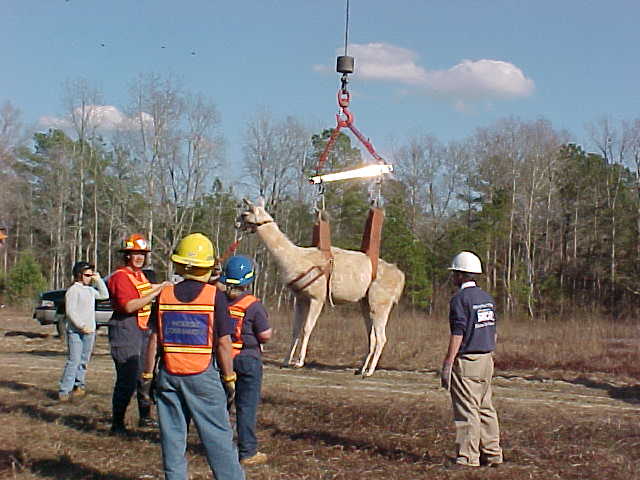
The above is a photograph of a relatively simple slinging system for short term use.
Dexter was not stressed at all by this procedure! Important details of its
application were taught so that the technique is performed correctly!
 |
To the left is the newly designed "Becker Sling".
This was unveiled at the
Kentucky Horse Park in August 2004
at a training course.
This simple vertical lift system can be purchased from
Large Animal Rescue Equipment at
Häst. |
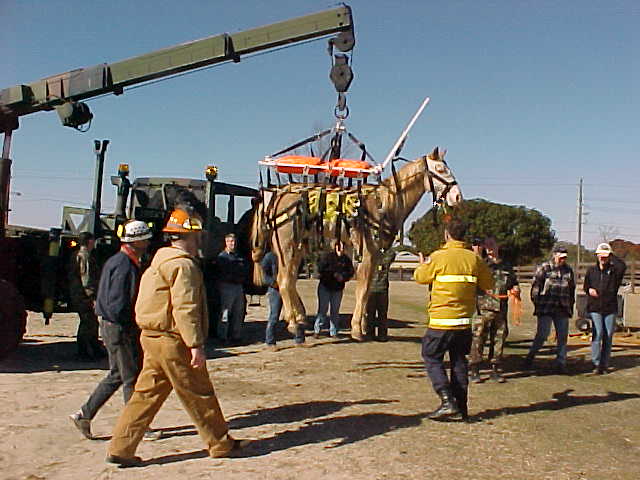
Above is the more elaborate Anderson Sling. This sling is the only one certified
for helicopter lifts. Recent modifications have made it faster to apply to the
patient and hook to the helicopter.
The class also includes night operations. This element stresses the need for
organization of the rescue team and illustrates how that organization can easily fall
apart. Continued training for various scenarios will help make future rescues
execute faster and safer. All scenarios undergo a post incident debrief to learn how
to make the next rescue better.
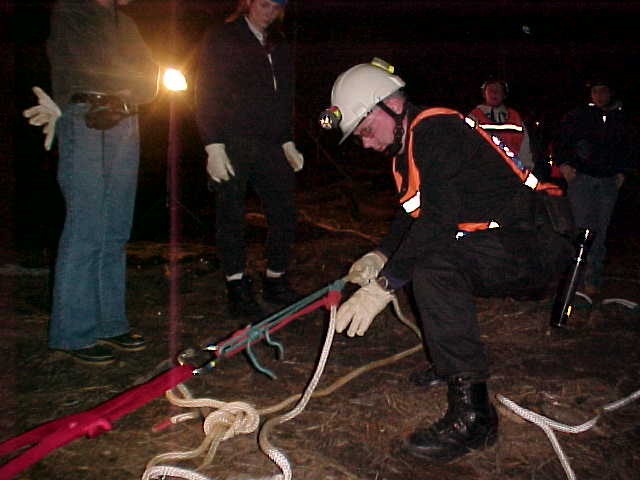
Above, Dr Becker is rigging a rope haul system to extricate a horse from a ravine using
the rescue glide. Packaging of the patient has a lot of similarities to human
extrications, but with some notable differences!
The next sequence was a demonstration of a horse caught in mud. Karma loves
jumping in mud and was quite at home during the "rescue". Watching their
buddy from a distance was Tornado the horse, and Possum the dog, who is just behind Tomas
Gimenez with the orange helmet. Rebecca Gimenez is in the foreground holding Karma.
TRACER team member Rich Baltzell is in the rescue harness on the other side of
Karma.
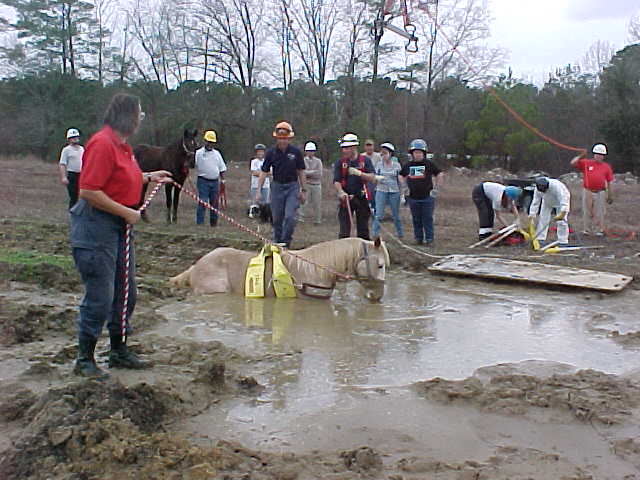
The equipment for a safe approach to the horse is being prepared in the background.
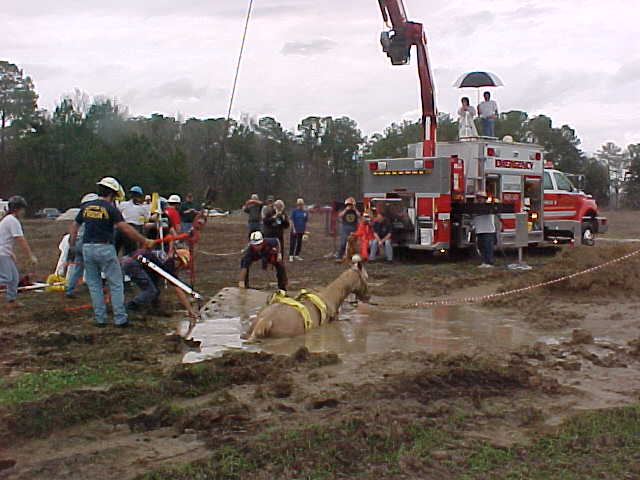
Then, the patient is approached. It is important that the rescuers maintain a
safe distance so that they themselves do not have to be rescued! A safety officer is
present at all exercises.
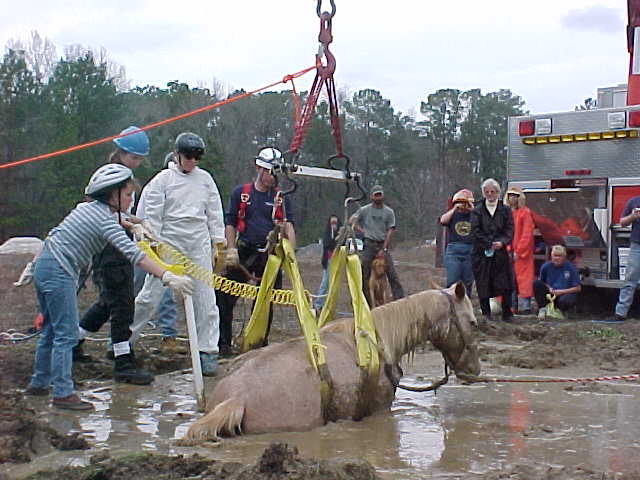
One of the hardest forces to overcome is the suction effect that the mud holds on its
victim. Techniques are shown that relieve those forces and allow the animal to be
safely lifted. Needless to say, the horse was given a bath by his mom after playing
in the mud! The rescuers had to bathe themselves.
Sometimes the safest approach to a rescue may involve righting an overturned trailer,
with the animals still inside!! This MUST be done slowly and carefully, using the
proper rigging to perform this maneuver in a controlled manor. Below, a horse
trailer, for demonstration purposes, is turned on its side. Then the process was
reversed, bringing the trailer upright again. The trailer was not scratched or
damaged at all using this technique. Any animal inside would have been given a slow
and steady ride with no further injuries.
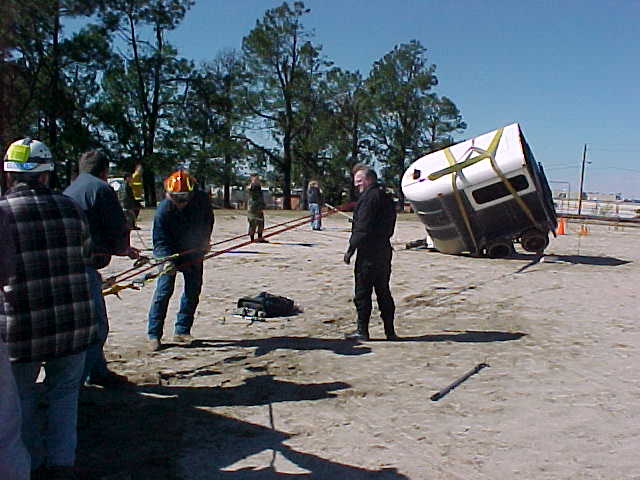
Editorial: The Large Animal Rescue Training course covered much more material
than one can see in these few photographs. This training was worth every minute, and
much much more! The dedication and professionalism of the instructors ranked at the
highest levels that this person has seen. It involved both practical and affordable
techniques. It is hoped that this training can be sponsored everywhere in the United
States and beyond. More information can be found at the Large Animal Rescue Training
page at Clemson University by clicking on the links below.
Training in Large Animal
Emergency Rescue
![]() I===I===I===I===I
I===I===I===I===I